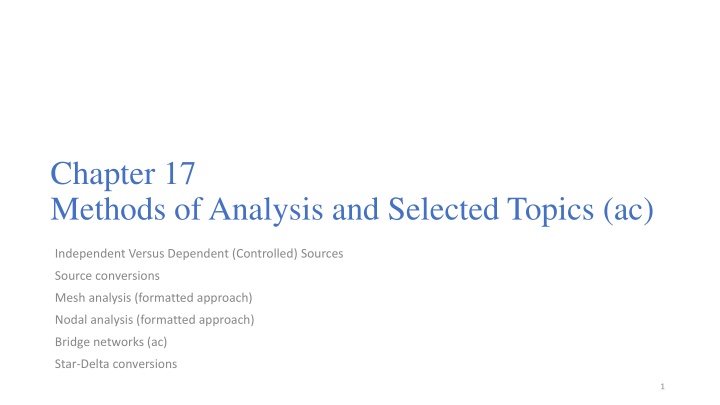
Methods of Analysis in Electric Circuits: Independent vs. Dependent Sources
Explore the concepts of independent and dependent sources in electric circuits, including voltage-controlled and current-controlled sources. Learn about mesh analysis, nodal analysis, source conversions, and more in this comprehensive guide with helpful visual examples.
Download Presentation

Please find below an Image/Link to download the presentation.
The content on the website is provided AS IS for your information and personal use only. It may not be sold, licensed, or shared on other websites without obtaining consent from the author. If you encounter any issues during the download, it is possible that the publisher has removed the file from their server.
You are allowed to download the files provided on this website for personal or commercial use, subject to the condition that they are used lawfully. All files are the property of their respective owners.
The content on the website is provided AS IS for your information and personal use only. It may not be sold, licensed, or shared on other websites without obtaining consent from the author.
E N D
Presentation Transcript
Chapter 17 Methods of Analysis and Selected Topics (ac) Independent Versus Dependent (Controlled) Sources Source conversions Mesh analysis (formatted approach) Nodal analysis (formatted approach) Bridge networks (ac) Star-Delta conversions 1
Independent and Dependent Sources An independent voltage or current source can be AC or DC but does not depend on other voltages or currents in the circuit. Dependent Sources Voltage-controlled voltage source (VCVS) Voltage-controlled current source (VCCS) Current-controlled voltage source (CCVS) Current-controlled current source (CCCS) 2
Mesh Analysis (Example) Loop 1: 5 ?6 ?1 4 ?8 ?2= 6.92 52.64 Loop 2: 4 ?8 ?1+ 4 ?2 ?2= 10 6
Mesh Analysis (Example) 6.92 52.64 10 5 ?6 4 + ?8 4 + ?8 4 ?2 4 + ?8 4 ?2 ?1= Loop 1: 5 ?6 ?1 4 ?8 ?2= 6.92 52.64 Loop 2: 4 ?8 ?1+ 4 ?2 ?2= 10 5 ?6 4 + ?8 5 ?6 4 + ?8 6.92 52.64 10 4 + ?8 4 ?2 ?2= = 1.27 86.92 ? 7
Mesh Analysis (Example) Loop 1: (?1+?2)?1 ?2?2= ?1 Loop 2: ?2?1+ ?2+ ?3?2= ??? ??= ?1 ?2?2 ?2?1+ ?2+ ?3?2= ? ?1 ?2?2 8
Supermesh Analysis (Example) Supermesh loop: ?1?1+ ?2?2= ?1+ ?2 Current Source: ?1 ?2= ?? 9
Supermesh Analysis (Example 2) Supermesh loop: 1? ?1+ 1? ?2+ 4? + ?6? ?3= 10 Current Sources: ?1= 6? 0 1? ?2+ 4? + ?6? ?3= 16 ?3 ?2= 0.1 ?? ??= (?1 ?2) 1? ?3 ?2= 100 ?1 ?2 99 ?2+ ?3= 0.6 10
Nodal Analysis (Example) ?1= 7 + ?8 ?2= 4 + ?5 ?3= ?10 ?4= 8 11
Nodal Analysis (Example) 1 ?1 +1 +1 1 ?3 ?2=?1 ?1 ?2 1 ?3 ?3 ?1 1 ?3 +1 ?1+ ?2= ?1 ?4 12
Supernode Analysis (Example) 1 1 ?1+ ?2= 5? 0 3?1 2? 1? ?2 ?1= 2?? ????1? ??= ?1 ?1= 2?? 1?= 2?1 1? 0.5? ?1+ 1? ?2= 5? + 6? ?1 5.5? ?1+ 1? ?2= 5? ?2 3?1= 0 2.5?1= 5? ?1= 2 ?,?2= 6 ? 13
Bridge Network IF: Then: 14
??????? 16
??????? 17












